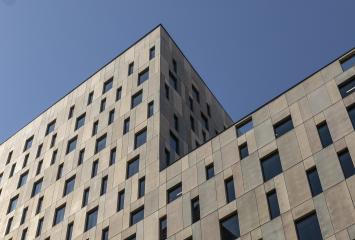Trends in sustainable architecture for 2025
The buildings that shape our society are responsible for 37% of all global carbon emissions, partly because, as explained by El Economista, many of these constructions are old enough to lack efficiency and sustainability measures: no quality insulation to prevent air leaks, no installations for water reuse, and no use of renewable energy of any kind. Of course, this has been changing for some time now, and every year new trends emerge to make architecture a more sustainable tool for our world. Let’s take a look at 2025’s trends.
Use of Sustainable Materials
Materials are the raw components of construction, and their level of sustainability largely determines the sustainability of buildings. In this regard, 2025 will intensify a trend that has been growing for years: the use of eco-friendly materials such as plant fibers, natural stone, or certified wood. At Colonial, for instance, we have Spain’s first ever office building made entirely of wood. Wittywood, located in Barcelona’s productive 22@ district, is a clear example. On the other hand, Torre BCN features environmentally certified flooring and was painted with eco-friendly paints that respect the environment.
Energy Autonomy
If all the buildings in the world produced their own energy, pollution would decrease significantly. Based on this premise, 2025’s architecture will focus on achieving energy autonomy, something Colonial has been implementing for many years. Miguel Ángel 23 incorporates self-production energy solutions, allowing the building to generate all the energy it consumes on-site, ensuring zero emissions balance. Along the same lines, Madnum is a complex that, through renewable energy sources and advanced energy efficiency technologies, achieves near-zero energy consumption.
Integration of Smart Technologies
This brings us to another trend: the implementation of smart technologies that reduce energy and resource consumption. At Colonial, this cutting-edge technology is known as Building Management System, enabling much more sustainable building usage. It is present in Recoletos 37, Génova 17, Castellana 52, Francisco Silvela 42, and many other locations in both Madrid and Barcelona. This technology monitors, controls, reports, and records all building activities, allowing for precise adjustments to its various systems. Expect to see more technologies like this in 2025.
More Biophilia Than Ever
There are two strong reasons why 2025 is expected to see an even greater commitment to biophilic design: first, it enhances sustainability at both the building and city levels, and second, its positive impact on human well-being makes it an attractive feature for companies looking to bring employees back to office spaces. The gardens of Sant Cugat Nord, the green area of Illacuna, the green space of Diagonal 682, and Madnum’s central park are great examples of Colonial’s commitment to this trend, which will continue to rise in the coming years. The green city is coming—more welcoming and sustainable.

